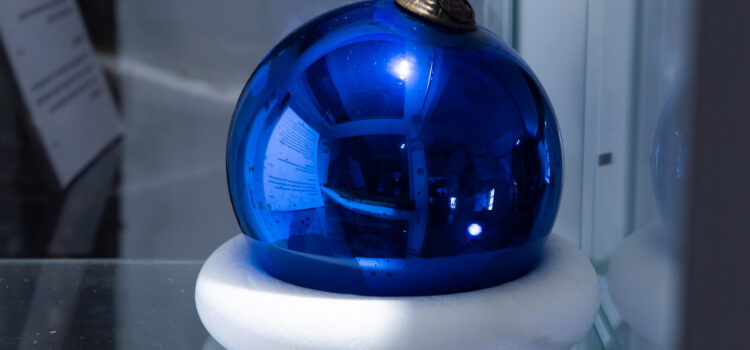There are many eye-catching objects at the Museum of Cambridge, but surely this is one of the most beautiful. Rightfully so – a little research shows that it was specifically made to catch and hold attention!
Exploring the folklore collection at the museum is just as fascinating as it is nerve-wracking, and this object is a very good example of that. You never know what you’re going to come across, or how fragile it will be, and a thin glass sphere from the eighteenth century definitely needs to be treated with the utmost care.
This is a witch ball, an object traditionally used to protect against evil forces (such as witches) entering the home. We have two of these here at the museum, both of which are a vivid blue colour. The one pictured here is on display in the Fen and Folklore Room, so be sure to keep a look out for it next time you pop in for a visit! It was made in 1721, in a village southwest of Cambridge called Gamlingay. It was hung in the window of a house, and the particular belief associated with it was that the light it refracted would dazzle witches and stop them coming in.
It is important to note that this was the belief associated with this object, because witch balls have a huge variety of folklore associated with them, and not every place or individual shared the same beliefs as another. One possible origin for them was as the glass buoys used for fishing nets, as many examples of witch balls look incredibly similar, and traditionally sailors’ wives would hang a glass float in their window to protect their husband while he was at sea. They potentially then became associated with witches because of the practice of ‘swimming’. This was where somebody accused of witchcraft was bound and dunked into a body of water. If they sank, then they were innocent (although sometimes they would have drowned before they were retrieved) and if they floated then they were a witch, as it was believed that because they had spurned baptism the water would reject them in turn. The potential link with buoys is that these were used to keep the fishing nets afloat, and therefore neither of them sank, although the connection has never been definitively confirmed.
Another belief connected to witch balls was that their reflective properties and bright colours mesmerised evil spirits, who would then touch the ball and be absorbed and trapped within it. In a 1942 edition of the Folklore Society’s journal, Gerald B. Gardner wrote that witch balls were displayed to avert the Evil Eye. This is a supernatural belief that has existed across the world for thousands of years and refers to a curse that is brought about by a glare, usually caused by envious feelings. Charms are used to deflect this, as it is believed that the Evil Eye hurts the first object that it falls upon. The witch balls in our collection do appear to link well with this, as they are designed to attract the eye, and are the same vivid shade of blue as most traditional Evil Eye charms.
Gardner also mentions that witch balls were often used as ornaments at the time he was writing. This supports the theory that these were what ultimately developed into our modern-day baubles. In fact, in a Time of Gifts, written by Patrick Leigh Fermour about his journey across Europe in 1930s, they appear exactly in this context:
‘Standing on chairs, the pretty daughters… were helping their father decorate a Christmas tree; hanging witch-balls, looping tinsel, fixing candles, and crowning the tip with a wonderful star’.
Although it is difficult to confirm all these beliefs and changes in function, just as it is with most objects connected to folklore, it is fascinating to study these possible developments and the changes they demonstrate. In particular, the idea that these glass balls might have moved from simply being fishing buoys, to protecting houses from witches, and then back to decorative ornaments, shows how societal beliefs and concerns are so clearly reflected in the objects we use every day.
The museum is full of these everyday objects, so why not come along and see what you can learn about the lives of Cambridge’s people through them?
References:
Gardner, G. (1942) ‘Charms, Amulets and Talismans’, Folklore, 53 (2) pp. 95-103.
Montani, C. (2019) ‘Collections, Heritage, Women’s History’, Historic Environment Scotland, Available at: The science of witchcraft – Historic Environment Scotland Blog (Accessed: 11/07/2024).
Editors of Encyclopaedia Britannica, The. (2018) ‘Witch Ball’, Encyclopaedia Britannica, Available at: Witch ball | Victorian Era, Folklore & Superstition | Britannica (Accessed: 11/07/2024).
